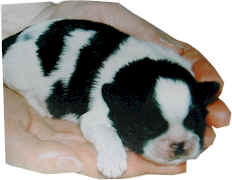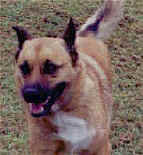| Home |
| About Us |
| Calendar |
| Photo Album |
| First Trial |
| Bylaws |
| World of Canines |
| Education |
| Membership |
| Contact Us |
| Links |
| Library |
| Guest Book |
ARTICLE ONE
WELCOME TO THE WORLD OF CANINES
In the Beginning
I left England in 1991 and traveled across the Atlantic to the warm tropical lands of the West Indies. This was a tuning point in my life and set me off on the road of hotel living and far away travel. I longed for the day when I would finally spend more than a few months in any one home and be able to have the life style that would accommodate a four legged friend.
I arrived on the shores of Hawaii having traveled from Southern Africa. Settled in to my new house and studied my surroundings. My home called out for a dog and my heart cried out for a puppy.
There she was, in black and white print advertised in the West Hawaii today.
|
Poi dog, 50.00. |
I scurried off to the dismay of my husband to purchase my first puppy. I still recall the echo’s of my husband’s pleas.
Research a puppy,
Lets learn about how we raise one,
We don’t even have supplies,
And finally we have spent more time researching the purchase of a car, a cold functional piece of equipment with no reliance on us for survival.
Those first few days were hard, we lost sleep, and worried about every move, and bought every book available determined to raise her correctly.
Her little feet soon turned into mechanisms to chase me all over the garden. Her teeth went from playful prongs to hard cold sharp nipping machines and I was soon heard to be saying “Help I have an aggressive dog”
In came Tammy (Paws University), four hours after my pleading call. “What
an adorable puppy” When will she start puppy school?
………………………………………. More next month
This journey we take is worth the effort – without ever needing to reach our destination. This world in which we live and travel with our canine partner.
The Canine, small, large, heavy, square, rectangular and sometimes almost round. Don’t they come in all types of shapes and sizes, each as adorable as the next.
Some days they are the perfect partner, a dream, a pleasure a gift and yet other days they appear to deliberately just blow us off, leaving us standing foolishly in their wake as they continue on doing what ever they need to do in their canine world
This very point in question is a large issue that many of us need to assess. Dogs do not deliberately set out to make us look like blundering fools, nor are they stubborn or stupid, and yet this is one of the first things we find ourselves saying as they turn back on the A frame or run out of the weaves at pole 9 after hours of patient extensive training.
But guess what, our beloved canines are the product of us and our training abilities. They reflect in our weakness and show us and anyone wishing to witness where we may best look for professional criticism and feedback.
In our lack of canine knowledge and understanding they are just great at showing the world all of our training floors on our very own primate stage shared with this wonderful and loyal four legged friend.
Training dogs is simple; it is the humans who make it tough. If we were to follow some basic principles in behavior and education and familiarize ourselves with canine learning theory wow we would be amazed at the results. Our canine friends would glow and prosper in their knowledge of our needs and desires and we would become more understanding and patient and ultimately more effective as coaches.
I prefer to think of myself as a coach, my best pal’s champion, support structure and educator. There to rally the motivation in both the good and the bad. I consider it my primary role to learn about my student, her needs and desires, her drives and sensitivities, her agenda and her program. Only then can I be a coach she would choose to employ, to work for, love and respect. Training is about enrollment, to enroll your canine into the fun and joy of learning and the motivation to display the learnt skills with a wag and a shake.
Characteristics of a Coach
Dependable Consistent Trusting Educator Communicator Support structure
So here goes, what’s first.
Overview of Training.
The wonderful thing about dogs is that they are capable under the correct circumstances of learning a variety of tricks and trades. Dogs have become developed to play a very important role in our lives, from the family pet to the rescue dog.
There are many types of dog training ranging from:
Obedience training, Canine Good Citizen through to Utility dog titles. Assistance dogs, Agility Fly ball Hunting and Field Trial Search & Rescue Protection Law enforcement
The process of teaching dogs has evolved over the past several decades. The best coaches understand how to use many training methods, more importantly the best coaches understand the methods which will work most effectively when working with individual dog.
Relevant Concepts of Biology
Life on earth varies from the small to the large, from arthropods to mammals. The family dog is one of these animals, it encompasses 38 living species. Of the 39 known species only one is extinct, the Falkland Islands Wolf
Selective Breeding & Taxonomy
Humans began to mold dogs for their various purposes. We began to select puppies that had loud insistent barks – the better to keep predators away and alert them to intruders... Humans also began to choose dogs that had puppy like behaviors including barking and chasing, without going in for the kill. Puppies that tended to be submissive and looked to us for leadership.
Taxonomy is how animals are classified into different categories based on their individual physical, genetic and biochemical relationship to one another.
Members of the dog family are terrestrial – they live on earth not in trees or underwater.
They are primarily nocturnal – meaning they hunt at night. They can maintain a trot or gallop for long distances – walking and running on their toes.
Dogs give birth to and care for their young in dens or burrow.
Canis familiaris
is the only member of this family that can be truly called domesticated.Other characteristics of the dog are: they have 42 teeth, 20 upper and 22 lower.
Dogs unlike cats can eat a variety of food types not just protein.
The History of Dogs
Scientists disagree about when dogs evolved from wolves but it was probably as early as 135,000 years ago to as late as 15,000 years ago. Not only do we not really know when they became domesticated but we are not sure how the domestication process evolved either.
It is believed that when humans began to abandon their hunter gatherer era and became farmers they were then capable of providing an environment that would allow for domestication. Dogs became assistants for humans, helping guard livestock and camps. Scientists can now prove that dogs descend from wolves and not jackals or other types of wild dog. People began to mold dogs for specific needs like finding game, these dogs developed into the hounds. Like hunting dogs, herd dogs were modified to meet specific needs, cattle dogs were developed to run along cattle. It is likely that dogs were also among the first draft animals, trained to pull carts and sleds.
Ethology of The Dog
Dogs share our lives all around the world, They are a fascination to us and a topic of study for any branches of science. No other species aside from humans have such a wide variety of looks and behavior.
Because dogs are such a large part of our lives it is important for people to understand what makes them do the things they do.
Without the knowledge of our canine friends life can be difficult for both of us.
Often Lack of canine understanding leads to anthropomorphizing (attributing human characteristics to non human objects) this will greatly affect the relationships we have with our dogs as we misunderstand their motivations and behaviors and apply theories to them which are not applicable.
The factors that affect canine behavior are
Natural instinct
Basic senses (vision, touch, smell, hearing, taste)
Drives, (prey, reproduction)
Past experiences.
We must take all of these into consideration when attempting to train and coach our dogs. The goal of training is to channel the dog’s basic behavioral patterns and drives to achieve a desired result. This is why it is important to understand canine behavior patterns and understand how a dogs mind works. When this requirement is ignored, the results are a confused dog and a frustrated coach.
To gain an understanding of canine behavior and psychology it is important to understand the following:
The dogs ancestry, including its descent The process of domestication The history of the selective breeding of dogs since domestication The ways in which the dog resembles and differs from the wolf The stages of canine development.
I believe that for professional dog coaches and individuals wishing to train a family pet the knowledge of the stages of canine development are vitally important. So here goes:
There are five stages of canine development; each stage has its own individual sensitivities and critical outcomes.
| Neonatal – This period begins at birth, pups are capable only of eating and sleeping. For the first two weeks of life they are blind and deaf staying close to their mothers who provide warmth and nourishment. 90% of their time is spent sleeping. (birth to two weeks) |  |
| Transitional
– The eyes and ears become operational and the pups begin to move
around. This is also when they start to develop social relationships
with one another. They continue to nurse frequently to fuel their
growth. Teeth start to emerge, and the pups are capable of learning.
(two to four weeks)
|
|
| Socialization
– Rapid brain development begins during the socialization period at
about three weeks of age. During this period, motor skills improve
especially in the area of walking, running and manipulating objects.
Social skills are learned at this age. Puppies are capable of displaying
a variety of facial expressions, vocalizations and body language. This
is when they start to bark and wag their tails, play with each other.
And learn to inhibit their bites. Puppies leave the whelping box to
eliminate and begin to explore the world around them. (five to twelve
weeks)
|
|
| Juvenile
– The motor skills improve and there is increased growth activity. The
permanent teeth come in. The puppy has reached about two thirds of its
actual size. This is an important stage; puppies should be exposed to as
many stimuli as possible to ensure they become a well balanced dog.
Harsh treatment at this age can damage a puppy for life. Puppies love to
explore and investigate. The juvenile age ends at the onset of puberty.
(12 weeks to puberty)
|
|
| Adult
- Six to nine months of age. Mental maturity and physical maturity
arrive at around 18 to 24 months or in some breeds at around three years
of age.
|
Niki's Poi dog, Dobie. |
Next month we will be featuring articles about the effects of domestication, dog’s sensory abilities, social behavior and communication and how dogs learn. If you have any questions about these topics then let us know by emailing us at
hawaiiCanineAcademy@hotmail.com I will ensure we answer any of your questions when putting together the features.Happy Coaching.
![]()
